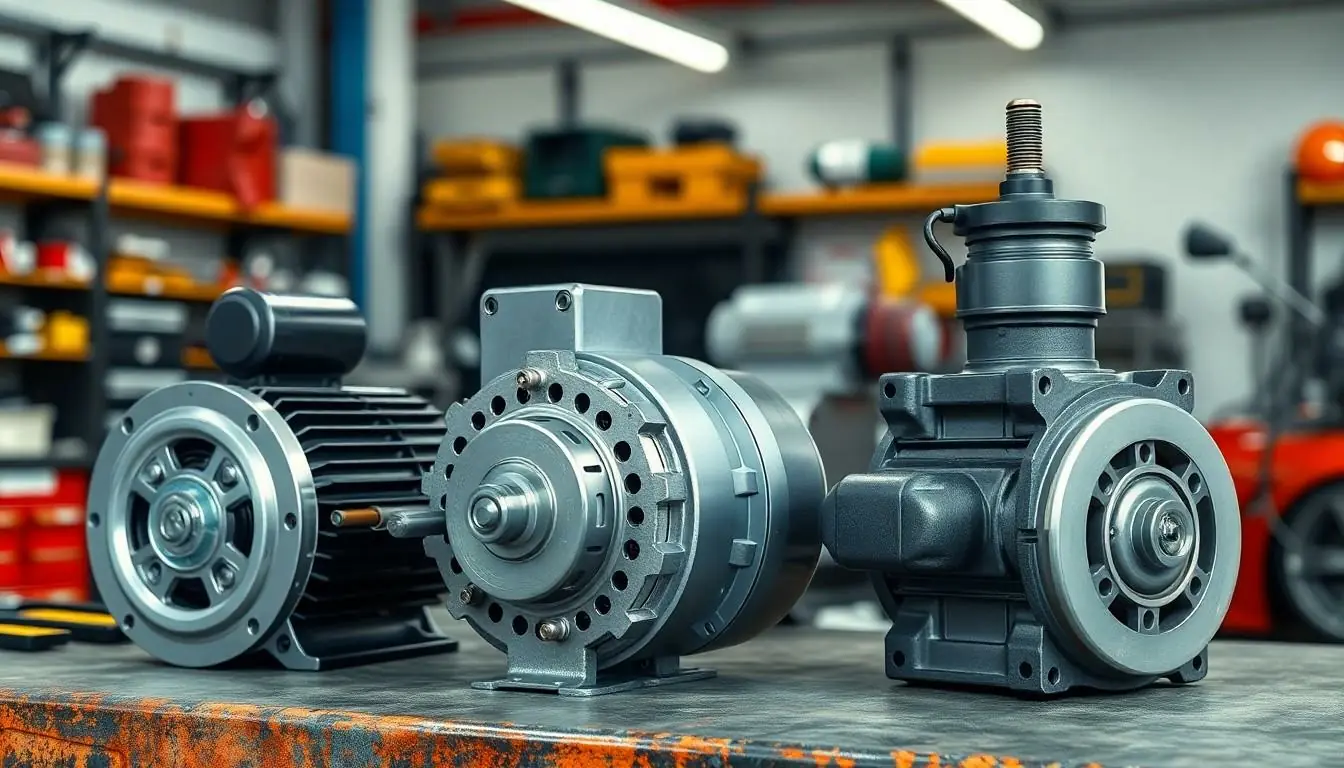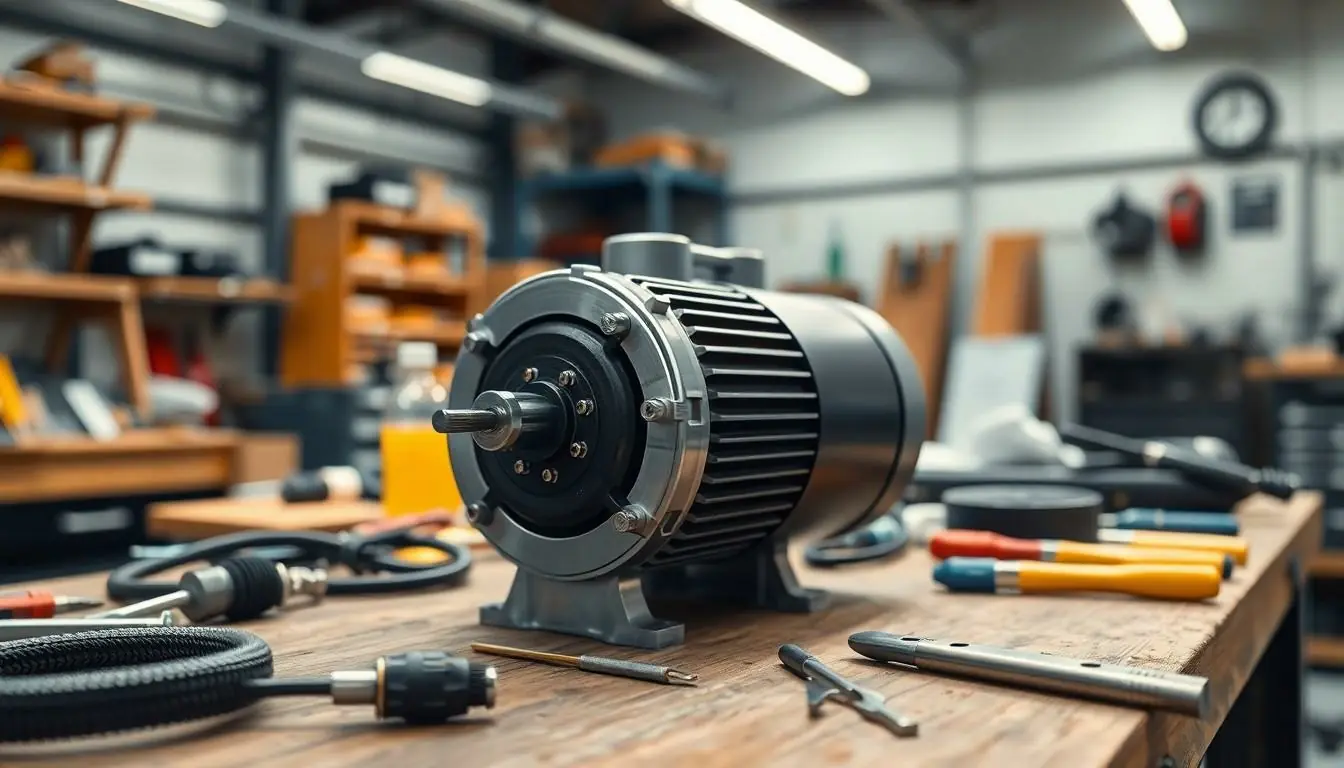Electric vehicles are zipping into the future, and at the heart of this revolution lies the unsung hero: the electric motor. These motors are like the quiet overachievers in high school—often overlooked but absolutely essential for getting things done. Without them, those sleek rides wouldn’t move an inch, and let’s be honest, nobody wants to be stuck in a parking lot with a glorified paperweight.
Table of Contents
ToggleOverview of Motors Used in Electric Vehicles
Electric vehicles (EVs) mainly utilize two types of motors: brushless DC motors and induction motors. Brushless DC motors excel in efficiency and reliability, making them popular in many EV models. They provide smooth operation and require less maintenance due to the absence of brushes that wear out over time.
Induction motors, on the other hand, are known for their robustness and cost-effectiveness. Many manufacturers choose this type for its high torque and reliable performance under various operating conditions. Tesla has successfully adopted induction motors in many of its models, benefiting from their durability and efficiency.
Another emerging option is the switched reluctance motor, which offers a simple design and high efficiency. This motor type features fewer components, leading to potential savings in manufacturing costs and weight. Research indicates that switched reluctance motors provide competitive performance compared to traditional types.
Magnet motors also find a place in the EV landscape, known for their compact size and lightweight design. These motors use permanent magnets to generate a magnetic field, enhancing performance. Their application supports improved acceleration and efficiency in various vehicle designs.
Ultimately, advancements in motor technology continue to shape the future of electric vehicles. Innovations in materials and design optimize performance and address efficiency concerns. As the EV market expands, the selection of motors adapts, ensuring each vehicle meets specific performance and economic requirements.
Types of Motors Used in Electric Vehicles

Electric vehicles utilize various types of motors, each offering unique features. The choice of motor significantly impacts performance, efficiency, and overall vehicle dynamics.
DC Motors
DC motors are prevalent in electric vehicles due to their straightforward control and high starting torque. These motors convert direct current into rotational motion effectively. They excel in applications requiring excellent torque at low speeds. Many smaller electric vehicles and hybrids integrate brushed or brushless DC motors to enhance efficiency. Maintenance for brushed DC motors can be frequent, while brushless variants reduce upkeep.
AC Motors
AC motors dominate the electric vehicle sector, particularly in larger models. Induction and synchronous AC motors maintain high efficiency across different speeds. Induction motors are robust, characterized by their cost-effectiveness and durability. They provide excellent torque and performance, especially at high speeds. Due to these advantages, manufacturers like Tesla favor AC motors for enhanced drive experience.
Permanent Magnet Motors
Permanent magnet motors stand out for their compact size and high efficiency. These motors use permanent magnets to create a magnetic field, leading to improved torque and reduced energy consumption. Their lightweight design benefits electric vehicles by increasing range and performance. Manufacturers often incorporate permanent magnet synchronous motors for optimized driving dynamics and energy management. Innovations in material science continue to enhance their capabilities, supporting the EV industry’s growth.
Advantages of Electric Vehicle Motors
Electric vehicle motors provide numerous advantages that enhance performance and sustainability. Their efficiency and power delivery are critical factors in the overall effectiveness of electric vehicles.
Efficiency
Electric vehicle motors exhibit high efficiency levels, often exceeding 90%. This efficiency results from their ability to convert electrical energy directly into mechanical energy with minimal losses. Brushless DC motors, for example, thrive in this area, requiring less maintenance than traditional motors. Induction motors also present strong efficiency ratings, contributing to reduced energy consumption during operation. These efficiency metrics lead to extended driving ranges and lower charging frequency, which benefits consumers and reduces the environmental impact of electric vehicles.
Torque and Power Delivery
Torque and power delivery play vital roles in electric vehicle performance. Electric motors deliver maximum torque instantly, allowing for rapid acceleration and smooth driving experiences. This immediate torque response contrasts with internal combustion engines, which require increased RPM to reach peak torque. Tesla’s utilization of induction motors showcases this advantage, providing powerful performance and dependable traction. Furthermore, permanent magnet motors enhance torque delivery and overall performance by employing efficient magnetic fields. This robust power delivery system ensures electric vehicles meet demanding performance expectations, making them suitable for daily driving and high-performance applications.
Challenges Faced by Electric Vehicle Motors
Electric vehicle motors encounter several challenges that can impact their performance and reliability.
Heat Management
Heat management stands as a critical challenge for electric vehicle motors. High operational temperatures can lead to reduced efficiency and damage to motor components. To combat this issue, manufacturers utilize advanced cooling systems, including liquid and air cooling options. These systems maintain optimal operating temperatures, ensuring longevity and sustained performance. Effective heat dissipation techniques also play a vital role in protecting sensitive electronic components within the motor, enhancing overall durability.
Cost and Manufacturing
Cost and manufacturing hurdles present significant challenges for the electric vehicle motor industry. Producing high-quality motors often involves expensive raw materials and sophisticated manufacturing processes. As demand for electric vehicles rises, pressures on supply chains can additionally drive costs upward. Economies of scale may help in reducing expenses, but achieving this in a rapidly expanding market remains complex. Innovations in manufacturing techniques, such as automation and 3D printing, offer potential pathways to lower production costs and improve motor availability.
Future Trends in Electric Vehicle Motor Technology
Future trends in electric vehicle motor technology focus on enhanced efficiency and performance. Manufacturers are increasingly researching solid-state batteries, which promise higher energy density and faster charging times. This advancement could transform how motors operate by providing more power while reducing weight.
Innovations in materials, such as lightweight composites and advanced magnet technologies, help optimize motor performance. Companies are developing high-energy magnets that improve torque while decreasing overall motor size. This reduction in size opens up design possibilities for more compact and efficient EVs.
The integration of artificial intelligence within motor systems plays a crucial role in enhancing predictive maintenance. Sensors equipped with AI can analyze motor performance in real-time, identifying potential issues before they escalate. Automakers are also using machine learning algorithms to refine motor control strategies, which can enhance vehicle responsiveness and driver experience.
Another significant trend is the ongoing exploration of alternative motor types, including axial flux motors. These designs offer higher power density and greater efficiency compared to traditional radial flux motors. As research progresses, manufacturers may find ways to scale production and reduce costs associated with these advanced motor types.
Developments in cooling technologies are critical to overcoming heat management challenges. Improved thermal management solutions, such as liquid cooling and advanced heat exchangers, help maintain optimal operating temperatures. These innovations extend motor lifespan, ensuring reliability in various driving conditions.
With rising demand for electric vehicles, a focus on sustainable manufacturing practices becomes increasingly important. Emphasizing recycling and reducing waste in the production process aligns with global sustainability goals. By prioritizing eco-friendly materials and processes, manufacturers contribute to the growth of the electric vehicle market while minimizing their environmental footprint.
Electric motors are the backbone of electric vehicles driving the future of sustainable transportation. Their efficiency and performance are crucial in shaping the driving experience and addressing the growing demand for EVs. As technology advances manufacturers are continually innovating to enhance motor capabilities while tackling challenges like heat management and production costs.
Emerging motor technologies promise to further elevate performance and efficiency ensuring that electric vehicles remain competitive in the automotive landscape. With a focus on sustainability and cutting-edge designs the evolution of electric motors will play a pivotal role in the ongoing transformation of the automotive industry. The future looks bright as electric motors continue to power the shift toward greener transportation solutions.

